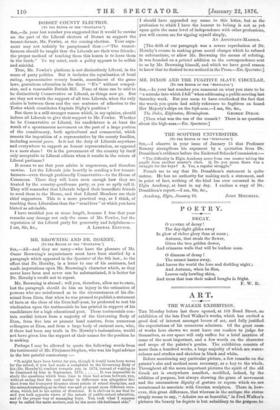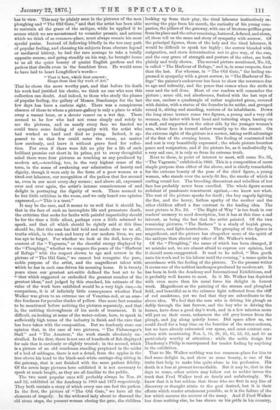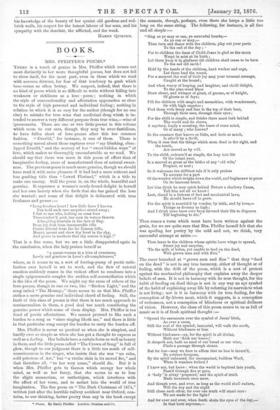ART.
THE WALKER EXHIBITION.
THE Monday before last there opened, at 168 Bond Street, an exhibition of the late Fred Walker's works, which has excited a good deal of interest amongst lovers of art, and fully justified the expectations of his numerous admirers. Of the great mass• of works here shown we must leave our readers to judge for themselves, as our space will only suffice for a brief mention of some of the most important, and a few words on the character and scope of the painter's genius. The exhibition consists of more than a hundred works, a large majority of which are water- colours and studies and sketches in black and white.
Before mentioning any particular picture, a few remarks on the painter's aim and method seem necessary, as a key to the whole. Throughout all the more important pictures the spirit of the old Greek art is everywhere manifest, modified, indeed, by the addition of purpose, but always showing the grace of movement and the unconscious dignity of gesture or repose which we are accustomed to associate with Grecian sculpture. There is, how- ever, this great difference, that whereas in the antique the statue simply seems to say, "Admire me as beautiful," in Fred Walker's pictures the beauty he depicts is but subsidiary to the purpose he has in view. This may be plainly seen in the pictures of the men ploughing and a The Old Gate," and that the artist has been able to maintain all the grace of the antique, while he applied it to scenes which we are accustomed to consider prosaic, and actions which we think of as common-place, must always remain his most special praise. Instead of .following blindly in the too easy path of popular feeling, and choosing his subjects from obscure legend or mediaeval history, he had the rare courage to take a totally -opposite course, and going steadily on his way, he brought home to us all the quiet beauty of quaint English gardens and the pathos that dwells even in the humblest lives. He would seem to have laid to heart Longfellow's words-
" That is best, which Heat nearest ; Shape from that thy work of Art."
That he chose the more worthy part, and that before his death his work had justified his choice, we think no one who sees this collection can doubt. And indeed, to those who study the phases of popular feeling, the gallery of Messrs. Deschamps for the last few days has been a curious sight. There was a conspicuous absence of those to whom a picture-gallery is only a place to while away a vacant hour, or a den der ressort on a wet day. There seemed to be few who had not come simply and solely to see the pictures, and on nearly every face we fancied we could 'trace some feeling of sympathy with the artist who had worked so hard and died so young. Indeed, it ap- peared to us that few could enter the room, no matter how carelessly, and leave it without grave food for reflec- tion. For even if there were felt no pity for a life of such brilliant promise cut short in its prime, yet to every thoughtful mind there were four pictures as touching as any produced by modern art,—touching, too, in the very highest sense of the term, in the sense of awakening our admiration of beauty and dignity, though it were only in the form of a poor woman or a -tired-out labourer, our recognition of the pathos that lies around us, even in our most every-day scenes ; and above all, expressed over and over again, the artist's intense consciousness of and delight in portraying the dignity of work. There seemed to be but little criticism in the room, and we only heard one opinion expressed,—" This is a treat."
It may be the case, and it seems to us well that it should be, that in the face of such an incomplete life and premature death, the criticism that seeks for faults with painful impartiality should be for the time a little silent, perhaps even a little ashamed to speak, and that all which should be rightly said at this time should be, that this man has laid hold and made clear to us all, truths which, in the rush and hurry of our modern lives, we are too apt to forget. For whether we look at the dull, heavy dis- content of the " Vagrants," or the cheerful energy displayed by the "Ploughing," whether we compare the peace of the "Harbour of Refuge" with the respect shown to age and sorrow in the picture of " The Old Gate," we cannot but recognise the pure, noble purpose of the artist, and the magnificent talent with which he has in each case driven his meaning home. It is twenty years since our greatest art-critic defined the best art to be 'a that which suggested or embodied the greatest number of the greatest ideas," and judged by this standard, his estimate of the value of the work here exhibited would be a very high one,—in comparison, it is of infinitely little consequence whether Fred Walker was given to an extreme use of Venetian-red, or an over- due fondness for peculiar shades of yellow. One more fact remains to be mentioned before noticing the pictures separately, and that is, the untiring thoroughness of his mode of treatment. It is difficult, on looking at some of the water-colour, here, to speak in sufficiently high terms of the industry in finish and the care that 'has been taken with the composition. But we fearlessly state our opinion that, in the case of two pictures, -" The Fishmonger's Stall" and "The Amateur," the work stands absolutely un- rivalled. In the first, there is not one of hundreds of fish displayed for sale that is carelessly or slightly treated ; in the second, which is a picture of an old coachman standing perplexed in the midst of a bed of cabbages, there is not a detail, from the apples in the tree above his head to the black-and-white carriage-dog sitting in the gateway, that is not finished with the same patient fidelity. Of the seven large pictures here exhibited it is not necessary to speak at much length, as they are all familiar to the public.
The two most popular ones will probably always be Nos. 48 and 52, exhibited at the Academy in 1869 and 1872 respectively. They both contain a story of which every one can feel the pathos. In the first, the picture of "The Old Gate," we have all the elements of tragedy. In the widowed lady about to descend the old stone steps, the peasant woman closing the gate, the children_ looking up from their play, the tired labourer instinctively re- moving the pipe from his month, the curiosity of his young com- panion, the pillars of the gateway, with one of its stone griffins gone from its place and the other remaining, battered, defaced, and alone, all,these tell us the same sad story of sympathy with sorrow. Of the principal figures, those of the lady and the tired labourer, it would be difficult to speak too highly ; the sorrow blended with resignation, and stern determination not to give way, of the one, and the easy grace of strength and posture of the other, are both plainly and truly shown. The second picture mentioned, No. 52, is called " The Harbourof Refuge," and is, in some respects, finer than the last. For whereas, in " The Old Gate," the feeling ex- pressed is sympathy with a great sorrow, in "The Harbour of Re- fuge" the painter's endeavour has been to show the reverence due to age and infirmity, and the peace that comes when the strife is over and the toil done. Most of our readers will remember the picture ; some old, red almshouses, flushed with the last rays of the sun, enclose a quadrangle of rather neglected green, covered with daisies, with a statue of the founder in its midst, and grouped rouncl it, sitting and standing, various of its inhabitants. Down the long atone terrace come two figures, a young and a very old woman, the latter with bent head and tottering steps, leaning on a staff, and supported on the other side by the younger woman's arm, whose face is turned rather wearily up to the sunset. On the extreme right of the picture is a mower, taking swift advantage of the first of the evening hours. The feeling of contrasted toil and rest is very beautifully expressed ; the whole picture breathes peace and resignation, and if the picture be, as it undoubtedly is, a very sad one, it is only so from its extreme truth.
Next to these, in point of interest to most, will come No. 35, "The Vagrants," exhibited in 1868. This is a composition of more simple purpose than either of the above, and is chiefly remarkable for the extreme beauty of the pose of the chief figure, a young woman, who stands over the newly-lit fire, the smoke of which is curling round her. The brooding discontent and rebellion of her face has probably never been excelled. The whole figure seems redolent of passionate resentment against,—we know not what. The rest of the picture speaks for itself ; the boy eagerly lighting the fire, and the heavy, listless apathy of the mother and the other children afford a fine contrast to the leading idea. The next picture is No. 39. "The Right of Way" is too fresh in our readers' memory to need description, but it has at this time a sad interest, as being the last that the artist painted. Of the two remaining pictures, "The Bathers" is a study of boyish grace, innocence, and light-heartedness. The grouping of the figures is magnificent, and the picture has altogether more of the spirit of the antique than almost any other of Mr. Walker's works.
Of the " Ploughing," the name of which has been changed, if we mistake not, we are almost afraid to express our opinion, lest it should seem exaggerated. It used to be called, " Man goeth unto his work and to his labour until the evening," a name quite in accordance with the feeling of the picture. To the present writer it seems one of the noblest landscapes produced by modern art. It has been in both the Academy and International Exhibitions, and is probably well known to most. In it Mr. Walker has depicted with even more than his usual force his delight in honest work. Magnificent as the painting of the stream and ploughed field, and beautiful as is the crimson light reflected from the cliff of red sandstone, yet we feel that they are subordinate to the above idea. We feel that the man who is driving his plough so deftly through the last furrow, and the boy who is driving the horses, have done a good day's work, and in a few minutes more will put on their coats, unharness the old grey horses from the plough, and jog along quietly home. Did space allow us, we could dwell for a long time on the beauties of the water-colours, but we have already exhausted our space, and must content our- selves with mentioning Nos. 5, 16, 20, 23, 45, 53, 62, and 60 as particularly worthy of attention ; while the noble design for Thackeray's Philip is unsurpassed for tender feeling by anything in the exhibition.
That to Mr. Walker nothing was too common-place for him to find some delight in, and show us some beauty, is one of the traits that help to make him quite alone in his profession. His death is a loss at present irremediable. But it may be, that in the days to come, other artists may follow out to nobler issues the track that Fred Walker trod so firmly and unfalteringly. We know that it is but seldom that those who are first in any line of discovery or thought attain to the goal desired, but it is their efforts which render attainment possible, as it is the failure of the few which ensures the success of the many. And if Fred Walker has done nothing else, he has shown us his pride in his country,
his knowledge of the beauty of her quaint old gardens and red- brick walls, his respect for the honest labour of her sons, and his sympathy with the desolate, the afflicted, and the weak.
Hann QVILTER.




































 Previous page
Previous page